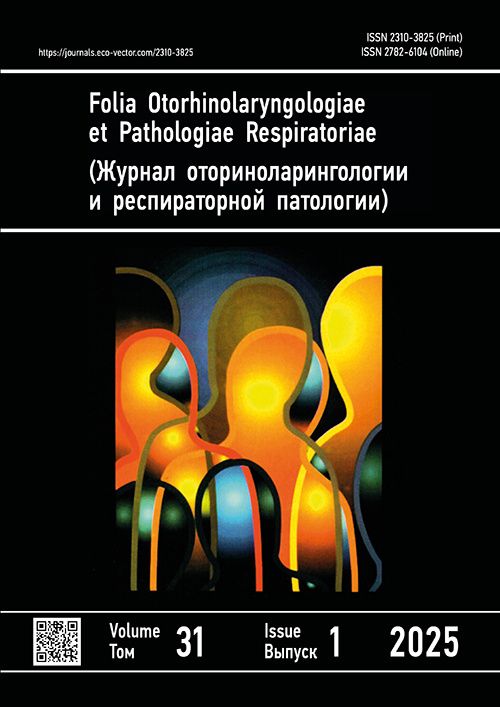Effect of long-term use of topical decongestants on mucociliary clearance
- Autores: Pokrovskaya E.M.1,2, Krasnozhen V.N.1,2, Zolotenin M.K.2, Batyrshin T.R.1
-
Afiliações:
- Russian Medical Academy of Continuous Professional Education
- Kazan Federal University
- Edição: Volume 31, Nº 1 (2025)
- Páginas: 29-33
- Seção: Original study
- ##submission.dateSubmitted##: 12.03.2025
- URL: https://journals.eco-vector.com/2310-3825/article/view/677100
- DOI: https://doi.org/10.17816/fopr677100
- EDN: https://elibrary.ru/SCSESK
- ID: 677100
Citar
Texto integral
Resumo
Background: The prevalence of drug-induced rhinitis in the population ranges from 1% to 7%. The result of long-term use of topical decongestants in rhinologic conditions suppresses mucociliary transport, making them unsafe.
Aim: To determine the effect of long-term use of topical decongestants on the mucociliary activity of the nasal mucosa.
Methods: The study involved 80 patients with drug-induced rhinitis aged 18–45 years. All patients were divided into 4 groups: group 1 (control group) included healthy participants; group 2 included patients who used topical decongestants for up to 1 year; group 3 included patients who use decongestants for 1–10 years, and group 4 included patients who used topical decongestants for more than 10 years. The ciliary beat frequency was examined using high-speed digital video microscopy. Video of 8–10 areas with intact ciliary beating was recorded using a high-speed video camera (Huateng Vision HT-SUA133GC-T) with the highest resolution (1,280 × 1,024 pixels) and frame rate (245 frames per second) installed to replace one microscope eyepiece. The average video frame rate was 132 ± 71.1 frames per second. The resulting videos were converted into a sequence of frames using the Free video to JPG converter software. Then, the sequence of frames was used in the CiliarMove app to calculate the ciliary beat frequency.
Results: The study did not show significant differences in the ciliary beat frequency of the inferior turbinate mucosa when using topical decongestants for 1 year and in healthy patients; whereas the ciliary beat frequency of the inferior turbinate mucosa in patients using topical decongestants for more than a year was significantly lower compared to healthy participants.
Conclusion: We revealed correlation between the duration of topical decongestant use and mucociliary activity.
Palavras-chave
Texto integral
Sobre autores
Elena Pokrovskaya
Russian Medical Academy of Continuous Professional Education; Kazan Federal University
Autor responsável pela correspondência
Email: epokrunia@inbox.ru
ORCID ID: 0000-0001-9437-4895
Código SPIN: 5051-9591
MD, Dr. Sci. (Medicine), Assistant Professor
Rússia, Kazan; KazanVladimir Krasnozhen
Russian Medical Academy of Continuous Professional Education; Kazan Federal University
Email: vn_krasnozhon@mail.ru
ORCID ID: 0000-0002-1564-7726
Código SPIN: 4020-8920
MD, Dr. Sci. (Medicine), Professor
Rússia, Kazan; KazanMaxim Zolotenin
Kazan Federal University
Email: mzolotenin@gmail.com
ORCID ID: 0009-0000-8303-3016
MD
Rússia, KazanTimur Batyrshin
Russian Medical Academy of Continuous Professional Education
Email: taha1429@yandex.ru
ORCID ID: 0000-0001-8449-9504
MD, Cand. Sci. (Medicine), Assistant Professor
Rússia, KazanBibliografia
- Fox N. The chronic effect of epinephrine and ephedrine on the nasal mucosa. Arch Otolaryngol. 1931;13(1):73–76. doi: 10.1001/archotol.1931.03660010083008
- Feinberg SM, Friedlaender S. Nasal congestion from frequent use of privine hydrochloride. J Am Med Assoc. 1945;128(15):1095–1096. doi: 10.1001/jama.1945.92860320001011
- Gray J. The mechanism of ciliary movement: VI. Photographic and stroboscopic analysis of ciliary movement. Proc R Soc Biol Sci Ser B. 1930;107:313–332. doi: 10.1098/rspb.1930.0075
- Proetz A. Essays on the applied physiology of the nose. St. Louis: Annals Publishing Co; 1953. 452 p.
- Canciani M, Barlocco EG, Mastella G, et al. The saccharin method for testing mucociliary function in patients suspected of having primary ciliary dyskinesia. Pediatr Pulmonol. 1988;5(4):210–214. doi: 10.1002/ppul.1950050406
- Miroshnichenko NA, Nikolaeva YuO, Savranskaya KV, Ryzhkova NS. Maintaining normal indicators of mucociliary transport is the basis for the adequate and correct use of local antiseptics. Effektivnaya Farmakoterapiya. 2024;16(20):10–13. (In Russ.) doi: 10.33978/2307-3586-2024-20-16-10-13 EDN: NRKDBM
- Dalhamm T. Mucous flow and ciliary activity in the trachea of rats and rats exposed to respiratory irritant gases. Acta Physiol Scand. 1967;36(123):432.
- Yager J, Chen T, Dulfano MJ. Measurement of frequency of ciliary beats of human respiratory epithelium. Chest. 1978;73(5):627-633. doi: 10.1378/chest.73.5.627
- Mareev OV, Mareev GO, Ermakov YuYu, Fedosov IV. Study of local mucociliary clearance in the middle nasal meatus in clinically healthy individuals and patients with foreign bodies in the maxillary sinus. Science and Innovations in Medicine. 2022;7(2):128–133. doi: 10.35693/2500-1388-2022-7-2-128-133 EDN: NOKKCG
- Chilvers MA, Rutman A, O’Callaghan C. Functional analysis of cilia and ciliated epithelial ultrastructure in healthy children and young adults. Thorax. 2003;58(4):333–338. doi: 10.1136/thorax.58.4.333
- Svistushkin VM. Inflammatory diseases of the upper respiratory tract in elderly patients: features of development and drug treatment. Consilium Medicum. 2003;5(12):686–690. EDN: UENWFL
- Mwimbi XK, Muimo R, Green MW, Mehta A. Making human nasal cilia beat in the cold: a real time assay for cell signalling II. Cell Signal. 2003;15(4):395–402. doi: 10.1016/S0898-6568(02)00143-2
- Smith CM, Hirst RA, Bankart MJ, et al. Cooling of cilia allows functional analysis of the beat pattern for diagnostic testing II. Chest. 2011;140(1):186–190. doi: 10.1378/chest.10-1920
- Cohen NA. Sinonasal mucociliary clearance in health and disease. Ann Otol Rhinol Laryngol Suppl. 2006;196:20–26. doi: 10.1177/00034894061150s904
- Shaari J, Palmer JN, Chiu AG, et al. Regional analysis of sinonasal ciliary beat frequency. Am J Rhinol. 2006;20(2):150–154. doi: 10.1177/194589240602000205
- Shilenkova VV. Frequency of cilia beating of the nasal translucent epithelium of the nasal cavity in healthy children. Russian Otorhinolaryngology. 2008;(2):87-89. (In Russ.) EDN: IULMHB
- Kramnoy AI, Kozlov BN. Effect of nasal decongestants on locomotor activity of the ciliary apparatus of nasal mucosa in patients with acute purulent rhinosinusitis. Russian Bulletin of Otorhinolaryngology. 2010;(1):67–68. EDN: OYENUJ
- Vasina LA. Effect of topical vasoconstrictor drugs on nasal mucociliary transport [dissertation]. Moscow: Russian Medical Academy of Postgraduate Education; 2010. 119 p. Available from: https://www.dissercat.com/content/vliyanie-mestnykh-sosudosuzhivayushchikh-preparatov-na-mukotsiliarnyi-transport-polosti-nosa (In Russ.)
Arquivos suplementares









